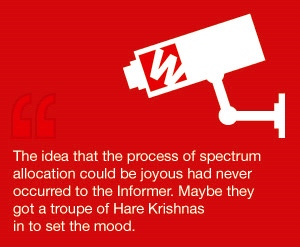October 25, 2013

By The Informer
At Broadband World Forum this week, Ericsson CEO Ulf Ewaldsson predicted – not for the first time, and probably not for the last – that spectrum will one day be more scarce a resource than oil. Perhaps this is why Telekom Austria was prepared to drop more than a billion Euros to stockpile half of all spectrum made available in the country’s recent auction, like Tesco buying up land so nobody else can use it.
TA revealed Monday that it had bagged four blocks of prime 800MHz territory (two thirds of the total on offer), three blocks at 900MHz and seven blocks at 1800MHz, giving it 2 x 140MHz, all in all. CEO Hannes Ametsreiter called the price “a bitter pill to swallow”, which “dampened the joy” of the experience. The idea that the process of spectrum allocation could be joyous had never occurred to the Informer. Maybe they got a troupe of Hare Krishnas in to set the mood.
If Ametstreiter was feeling uncomfortably damp his opposite number at 3’s local operation, Hi3G Austria was, in marked contrast, absolutely fuming. The auction result, said Jan Trionow, was “a disaster for the industry”. It’s hardly surprising he was upset; the high price kept 3’s winnings to just 2 x 25MHz, while T-Mobile took 2 x 45MHz. Trionow suggested that 3 had at least escaped exposure to huge cost, but the fact remains that, post its purchase of Orange, it has real limitations in its Austrian Spectrum holding.
The auction drew external as well as internal criticism, with CEO of spectrum specialist Coleago Consulting Stefan Zehle arguing that 3 had been unfairly treated by the Austrian regulator. The fact that TA had been able to acquire such a large share of spectrum on offer (it now holds 53.8 per cent of all sub-1GHz real estate despite having less than 40 per cent market share) suggested “the Austrian government is not particularly concerned about the effects of spectrum concentration on competition,” Zehle said. This was not the case when 3 was forced to divest certain spectrum assets as part of the Orange deal, he added.
Bengt Norström of Swedish consultancy Northstream said the result was an illustration of “the insanity of auctions”, favouring the player with the strongest legacy business and greatest capacity for investment. “Nothing has been done to safeguard the continued existence of competition,” came his lament.
But “insanity” didn’t go far enough for Zehle, who suggested that “governments can hold a gun to operators’ heads and demand almost any price.” It’s a nice image. Especially if you factor in the Hare Krishnas trying to calm things down.
Moody’s promptly downgraded TA’s debt ratings, as the operator will fund its spectrum binge with more debt.
Speaking of matters financial there were a fair few quarterly results out this week. UK operator EE grew its postpaid LTE subscriber base by 72 per cent during the third quarter this year, ending the quarter on almost 1.2 million users. But at £1.43bn the firm’s service revenue was down 3.3 per cent year on year and 4.4 per cent sequentially as it continued to absorb the impact of regulation on termination rates and roaming charges.
The operator reported a year on year increase of 5.7 per cent in its postpaid user base, adding net 181,000 postpaid users during the quarter. And while it lost 345,000 prepaid users it said that postpaid users are currently generating six times the ARPU of prepaid. Year on year the firm’s total subscriber base dropped by 2.7 per cent to 27.4 million. There was no mention of profit – the firm is planning a partial IPO next year so it’s trying to keep things upbeat, and financially leak-proof.
In other UK news, EE announced an extension of its MVNO hosting deal with VirginMobile.
Also avoiding any mention of profit was EE parent Orange, which did concede that its revenues had dropped four per cent year on year to €10.16bn. For Orange the impact of regulation actually lessened, as its Q2 revenues dropped year on year by 4.8 per cent. Spain and Poland turned in revenue increases but France and the rest of Europe were dragging them down, with Belgium down by 10.1 per cent. There’s not much good stuff for the mobile operators coming out of Belgium at the moment, is there.
Ericsson, meanwhile, managed to turn a three per cent drop in sales into a 38 per cent profit uptick, thanks to some iron fisted cost management, no doubt, turning in SEK3bn for the quarter. Support Solutions dropped 29 per cent year on year thanks to divestments, portfolio changes and “somewhat lower sales of compression technology.
Network sales dropped a fraction to SEK26.7bn, but the margin doubled to ten per cent. The problem is that Ericsson’s big LTE projects in the US and Japan have peaked and are now moving to conclusion, said CEO Hans Vestberg. So now the firm is looking to China and Europe for the next wave. Maybe Vestberg should give Hannes Ametsreiter a tinkle.
One of those big LTE projects was with AT&T, which this week reported quarterly revenues up 2.2 per cent year on year to $32.2bn. Net profit was up from $3.6bn to $3.8bn. During the quarter AT&T added almost one million subscribers and service revenues for wireless were up 3.7 per cent year on year to $15.5bn. Data revenues accounted for more than a third of this amount, and were up more than 17 per cent year on year.
It was interesting to note that, while fixed revenues were down one per cent year on year, the firm’s U-verse pay-TV service had a record quarter, with revenues growing 28.1 per cent year on year. The service also recorded its first ever billion dollar month.
Pay TV is increasingly appealing to telcos, fixed and mobile, as a way of increasing their stickiness. There was evidence of this from the Nordics this week, as Norwegian operator Telenor moved to consolidate its position in the Swedish broadband and television services sector with the acquisition of Tele2Sweden’s fiber and cable business for SEK775m ($121.4m).
Tele2 has some 370,000 households connected with fiber and cable, including 125,000 fixed broadband customers, 75,000 digital TV customers and 220,000 cable TV customers. The deal includes the transfer of 68 staff.
If approved, the transaction will propel Telenor from a close third to a strong second place in the Swedish broadband market, with 723,000 subscriptions, according to figures from Informa’sWBIS, behind incumbent Telia.
“In today’s society, access to high-capacity broadband plays a very central role for most people. Telenor aims to provide optimal connectivity and we want to continue our commitment on fixed broadband and TV through our brand Bredbandsbolaget. This topic is a priority for us and our new customers and employees will play a vital role in our business going forward,” said Lars-Åke Norling, CEO of Telenor Sweden.
The deal raises questions about the potential for further consolidation in the Swedish market, including the mobile sector which sees five operators competing in a market of less than ten million people and 14.56 million mobile connections. With 2.4 million mobile connections Telenor is in third place in the Swedish mobile market, behind Tele2 with 3.8 million and TeliaSonera with 6.7 million, and ahead of Hutchison’s3 with 1.58 million, according to Informa’s WCIS+.
But any consolidation would be likely to also involve Sweden’s leading pay-TV and broadband provider, ComHem, currently owned by private equity firm BC Partners, said Bengt Nordström. “Both Telenor and Telia have the right portfolio, they have fixed and mobile broadband and they both have TV. Those are the components you need to be a long term player in the market,” said Nordström. “A third quad-play player has to emerge from Tele2 and 3 and Com Hem, or any combination thereof but it’s not yet clear how that will happen,” he said.
Let’s just skip back to AT&T now. The firm also announced this week that it is to sell approximately 600 of its wireless towers to independent infrastructure management firm CrownCastle, and lease the rights to another 9,100 towers, for a combined up-front payment of $4.85bn. AT&T will lease capacity back from Crown Castle, for a minimum of ten years, for $1,900 per month per site, with annual rent increases of two per cent.
Crown Castle has the right to buy the leased towers when the leases expire for some $4.2bn. A typical lease term is 28 years, AT&T said. Meanwhile Crown Castle can also lease capacity at the sites to other network operators, although AT&T will have “access to additional reserve capacity on the towers for future use.”
Crown Castle has deals in place with Verizon, Sprint and T-Mobile as well as AT&T and owns or operates more than 30,000 sites. The firm reported 3Q13 revenue of $749m, a 21 per cent increase on the same period for 2012. Site rental revenue grew by 15 per cent to $621m, while EBITDA for the period grew ten per cent year on year to $441m.
As you might have gathered from the opening to this week’s edition, the Informer has been in Amsterdam this week, pressing the flesh…. at BroadbandWorldForum, before you start getting smutty. So here’s a little round up of what we saw over there.
DeutscheTelekom VPfor aggregation, transport, IP and fixed access Axel Clauberg introduced a buzzword, because if there’s another thing the industry needs right now, it’s a new triple-barrelled buzzword: the Software Defined Operator.
With Software Defined Networking (SDN), virtualisation and cloud dominating much of the discussion at the event, many operators see abstraction of the software layer and virtualisation of hardware as key to managing the anticipated surge in data. And essentially, by combining SDN, NFV and simplifying the protocols they use, the DT exec believes operators can prepare themselves for future data demands.
In his keynote speech, Clauberg questioned whether support for IPv4, MPLS and IPv6 among others is really necessary. He said that IPv6 will be the only address protocol in DT’s core, whereas IPv4 will be supported as a service in the network and the core will be simplified through reliance on fewer protocols for tunnelling, DHCP, 100 GE and IPv6.
“The biggest pain for us is that there is so much legacy technology in networks that it is difficult to bring new services to the market. We need to be able to program new services without rearchitecting the network,” he said.
This is something of a sore point for operators, which have seen over the top players exploit their networks without bearing any of the investment costs.
“We have been structured in silos typically,” he said. “But internet companies such as Facebook and Google don’t have silos, they have people who have programming, engineering and operational skills. So we also have to bring new skill sets into our organisation and staff teams in a different way.”
Another observation made at the show was that the industry is using outdated, inaccurate and confusing terminology. Erik Hoving, group CTO of Dutch operator KPN, likened the state of the industry, weighed down with acronyms – GSM, HSPA, LTE – to periods of technological revolution in the past when society simply didn’t have the words to describe such advances.
“Think about the terminology: magic lantern; horseless carriage; smartphone,” he said. “These words don’t really describe the technology they are attached to. Acronyms have been the essence of this industry for 30 or 40 years now but nobody on the street knows what LTE means, so we must be marketing it wrong.”
Ericsson CTO Ulf Ewaldsson noted a change in language and behaviour in the way networks are being used. This is largely due to the fact that Ericsson is seeing a shift in its own customer base.
“Our customer base is changing a lot because new requirements are coming from other industries,” Ewaldsson told the Informer. “Technology requirements used to come from the operators but now they come from the operators’ customers.
The customers I deal with are not super techie, they are businessmen and we need to translate all this technology down to a level that these executives can understand.”
Hoving’s keynote also focused on how to change network architectures to build an internet better designed for a generation that has grown up with broadband access. By moving to a fully integrated access play incorporating wifi, 2G, 3G, 4G, fibre and copper, “mobile broadband will be so big that access won’t be the problem anymore. But today’s internet is designed for ‘fixed’ usage. So in the future it needs to be redesigned for mobile because people will start to use broadband differently than they do now.
“We must change from innovating in the network to innovating on the network,” Hoving said, “because the average smartphone user interacts with their device more than 150 times per day. Service providers do not have teenagers on their advisory boards yet their knowledge of how the network is used is crucial to steering a telecoms operator.”
Kevin Lo, general manager of GoogleFiber, the internet giant’s US focused internet access play, backed up Hoving’s comments and gave an insight into network rollout from a greenfield perspective. To date, Google has rolled fibre out to users’ homes in Kansas City, Austin, Texas and Provo, Utah and is already seeing significant innovation in those areas as a result of high speed connectivity. “Fibre-ing up Kansas actually took the area to a point where it had more tech jobs than Silicon Valley,” Lo said. “And the next 100x improvement in speeds will lead to more innovation. We can’t even imagine what the next set of gigabit speed apps will do.”
Lo said that when dealing with existing communications infrastructure that was built bit by bit over the course of the last century the challenge is to redesign the infrastructure in order to coax more speed out of the network and drive more innovation.
“When we rebuilt Google Maps from the ground up in order to make it load faster, usage went up 25 per cent. So it’s a myth that consumers won’t pay for high speed broadband. We can say with full confidence that there is huge consumer demand,” Lo said.
So when Google wants to deploy fibre in a market the first thing the company does is sit down with the city’s authorities and discuss the pace of evolution, as only by making existing infrastructure available to new providers will new build outs be encouraged.
“Local government can actually play a large role in reducing the complexity of fibre networks just by giving new entrants access to maps of infrastructure, including maps of gas and water mains and things like expedited construction permits,” he said. “And as a result, community driven local initiatives can make a big impact in bridging the digital divide.
The EuropeanCommission’s head of the unit for Broadband Policy Anna Krzyzanowska also gave a keynote address at the show, in which she outlined the Commission’s intention to, rather than drive broadband investment across member states using Commission funding, “unlock opportunities” for private sector projects.She said that Europe needs “visionary investment” as financial backing for broadband networks in Europe is lagging behind other regions in the world.
And when operators are still paying €1bn for LTE spectrum, it’s not hard to see why.
Take care
The Informer
Read more about:
DiscussionYou May Also Like





.png?width=300&auto=webp&quality=80&disable=upscale)

.png?width=300&auto=webp&quality=80&disable=upscale)
_1.jpg?width=300&auto=webp&quality=80&disable=upscale)



.png?width=800&auto=webp&quality=80&disable=upscale)